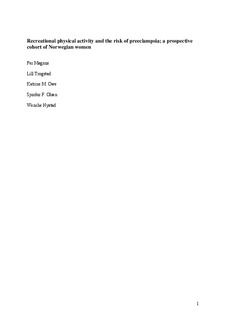| dc.contributor.author | Magnus, Per | |
| dc.contributor.author | Trogstad, Lill | |
| dc.contributor.author | Owe, Katrine M. | |
| dc.contributor.author | Olsen, Sjurdur F. | |
| dc.contributor.author | Nystad, Wenche | |
| dc.date.accessioned | 2010-04-30T08:56:08Z | |
| dc.date.available | 2010-04-30T08:56:08Z | |
| dc.date.issued | 2008-08-13 | |
| dc.identifier | Seksjon for idrettsmedisinske fag / Department of Sports Medicine | |
| dc.identifier.citation | American Journal of Epidemiology. 2008, 168(8), 952-957 | en_US |
| dc.identifier.issn | 0002-9262 | |
| dc.identifier.uri | http://hdl.handle.net/11250/170609 | |
| dc.description | I Brage finner du siste tekst-versjon av artikkelen, og den kan inneholde ubetydelige forskjeller fra forlagets pdf-versjon. Forlagets pdf-versjon finner du på www.oxfordjournals.org: http://dx.doi.org/10.1093/aje/kwn189 / In Brage you'll find the final text version of the article, and it may contain insignificant differences from the journal's pdf version. The definitive version is available at www.oxfordjournals.org: http://dx.doi.org/10.1093/aje/kwn189 | en_US |
| dc.description.abstract | Previous case-control studies suggest that recreational physical activity protects against preeclampsia. Using a prospective design, the authors estimated the risk of preeclampsia for pregnant women according to level of physical activity, taking other variables that influence risk into consideration. The data set comprised 59,573 pregnancies from the Norwegian Mother and Child Cohort Study (1999-2006). Information on physical activity and other exposures was extracted from questionnaire responses given in pregnancy weeks 14-22, whereas diagnosis of preeclampsia was retrieved from the Medical Birth Registry of Norway. Estimation and confounder control was performed with multiple logistic regression. About 24% of pregnant women reported no physical activity, and 7% reported more than 25 such activities per month. The adjusted odds ratio was 0.79 (95% confidence interval: 0.65, 0.96) for preeclampsia when comparing women who exercised 25 times or more per month with inactive women. The association appeared strongest among women whose body mass index was less than 25 kg/m(2) and was absent among women whose body mass index was higher than 30 kg/m(2). These results suggest that the preventive effect of recreational physical activity during pregnancy may be more limited than has been shown in case-control studies and may apply to nonobese women only. | en_US |
| dc.language.iso | eng | en_US |
| dc.publisher | Oxford | en_US |
| dc.subject | body mass index | en_US |
| dc.subject | cohort studies | en_US |
| dc.subject | exercise | en_US |
| dc.subject | pre-eclampsia | en_US |
| dc.subject | pregnancy | en_US |
| dc.title | Recreational physical activity and the risk of preeclampsia: a prospective cohort of Norwegian women | en_US |
| dc.type | Journal article | en_US |
| dc.type | Peer reviewed | en_US |
| dc.subject.nsi | VDP::Medical disciplines: 700::Health sciences: 800 | en_US |
| dc.source.pagenumber | 952-957 | |
